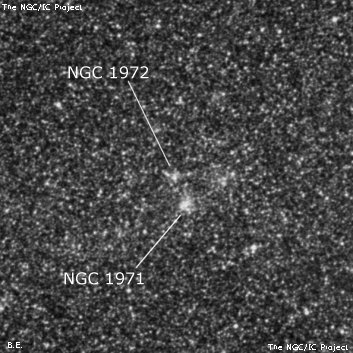
James Dunlop discovered NGC 1972 (or NGC 1971) = D 93 on 24 Sep 1826 and described "a very faint nebula, about 30" diameter." His position is ~5' SE of the trio NGC 1969/1971/1972. Based on my visual observation I suggest that NGC 1971 = D 93, although Steinicke assigns D 93 to NGC 1972. JH independently discovered this cluster (h2876) on 23 Dec 1834 and recorded it as "the 6th of several [including NGC 1950, 1958, 1959, 1969 and 1971] running together (fig 7, Pl IV). This also is a double nebula, having a very small one attached N.p (No 7)." His position is ~40" too far south.
Joseph Turner sketched the field (along with NGC 1958, 1969 and 1972) on 21 Dec 1875 using the 48" Great Melbourne Telescope. See plate III, figure 29 at www.docdb.net/history/texts/1885osngmt________e/index.php#m_3_29
600/800mm - 24" (4/7/08 - Magellan Observatory, Australia): forms the northeast vertex of a small triangle of clusters with NGC 1971 0.9' SSW and NGC 1969 1.4' E (within stellar association LH 59). At 260x this small cluster is bright, round, ~35" diameter (smaller than NGC 1971). There is either a very small knot of stars at the east edge (DSS reveals an apparent close double star). These clusters are buried with the southeast side of the LMC's bar, so the field has a bright background.
Notes by Steve Gottlieb